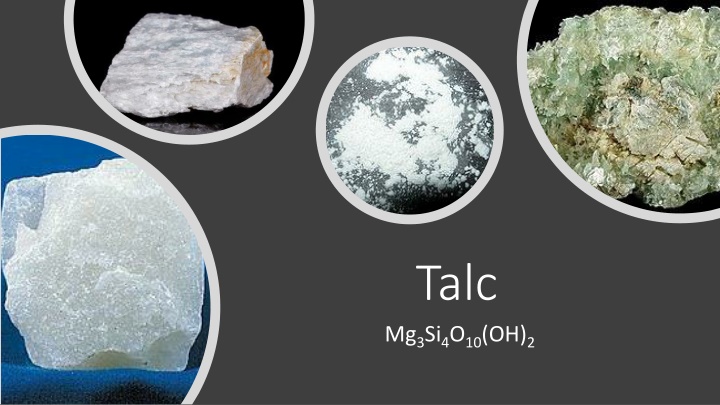
Characteristics and Uses of Talc: Formation, Production, and Health Risks
Discover the characteristics, formation process, distribution, and applications of talc. Learn about talc's structure, mining sources, and potential health risks associated with its usage.
Download Presentation

Please find below an Image/Link to download the presentation.
The content on the website is provided AS IS for your information and personal use only. It may not be sold, licensed, or shared on other websites without obtaining consent from the author. If you encounter any issues during the download, it is possible that the publisher has removed the file from their server.
You are allowed to download the files provided on this website for personal or commercial use, subject to the condition that they are used lawfully. All files are the property of their respective owners.
The content on the website is provided AS IS for your information and personal use only. It may not be sold, licensed, or shared on other websites without obtaining consent from the author.
E N D
Presentation Transcript
Talc Mg3Si4O10(OH)2
Characteristics Color: Green, white, gray, brown, colorless Crystal system: Triclinic, Monoclinic Crystal habit: Foliated to fibrous mass Hardness: 1 Luster: Sub-vitreous, Pearly, Waxy Streak: White to Black Cleavage: Perfect Specific gravity: 2.58-2.83
Structure Mg3Si4O10(OH)2 Talc is a phyllosilicate; Its layered structure is held together only by van der Waal s bonds. Its layered sheets resemble that of mica. The mineral can make the following substitutions in small quantities: Al, Ti Si Fe,Mn,Ca,Al Mg
Formation Talc forms through the metamorphism of magnesian materials. This process is called talc carbonation or steatization. (serpentine)2 Mg3Si2O5(OH)4+ (carbon dioxide)3CO2 (talc)Mg3Si4O10(OH)2+ (magnesite)3 MgCO3+ (water)3 H2O Another method of formation uses the reaction between dolomite and silica that commonly occurs in silica-rich metamorphic areas. (dolomite)3 CaMg(CO3)2+ (silica)4 SiO2+ (water)H2O (talc)Mg3Si4O10(OH)2+ (calcite)3 CaCO3+ (carbon dioxide)3 CO2 Talc is found in ~2000MA ultramafic rock and near convergent plate boundaries.
Production Distribution China ~30% (2.2M tonnes/yr) Brazil ~12% India ~11% United States ~9% France ~6% Finland ~4%
Uses In it s powdered form talc absorbs moisture well. Often used as a filler in plastics and ceramics. Due to its unusual softness it reduces friction between materials such as mechanical parts. (E.g. painting tools/sprays)
Mining Texan Talc Mine: https://www.youtube.com/watch?v=bOKeZBzFnf8 Afghan insurgency: https://www.youtube.com/watch?v=z9acG6aWCoI
Health Risks https://www.dovemed.com/healthy- living/first-aid/first-aid-talcum-powder- poisoning/ A study by the US National Toxicology Program proved it cancerous. Often used to dilute recreational drugs. At 1000mg/m3talc inhalation is considered lethal. Swallowing in large quantities is harmful. Talc is often found near serpentine and amphiboles, risking exposure or contamination by asbestos.
What Is Talc? North America, Inustrial Mineral Associationn, https://www.ima-na.org/page/what_is_talc. The Editors of Encyclopaedia Britannica. Asbestos. Encyclop dia Britannica, Encyclop dia Britannica, Inc., 27 Sept. 2019, https://www.britannica.com/science/asbestos-mineral. Talc: The Softest Mineral. Geology, https://geology.com/minerals/talc.shtml. Halkar, S. K. Talc - an Overview | ScienceDirect Topics, https://www.sciencedirect.com/topics/earth-and-planetary- sciences/talc. https://www.dovemed.com/healthy-living/first-aid/first-aid- talcum-powder-poisoning/ References






















